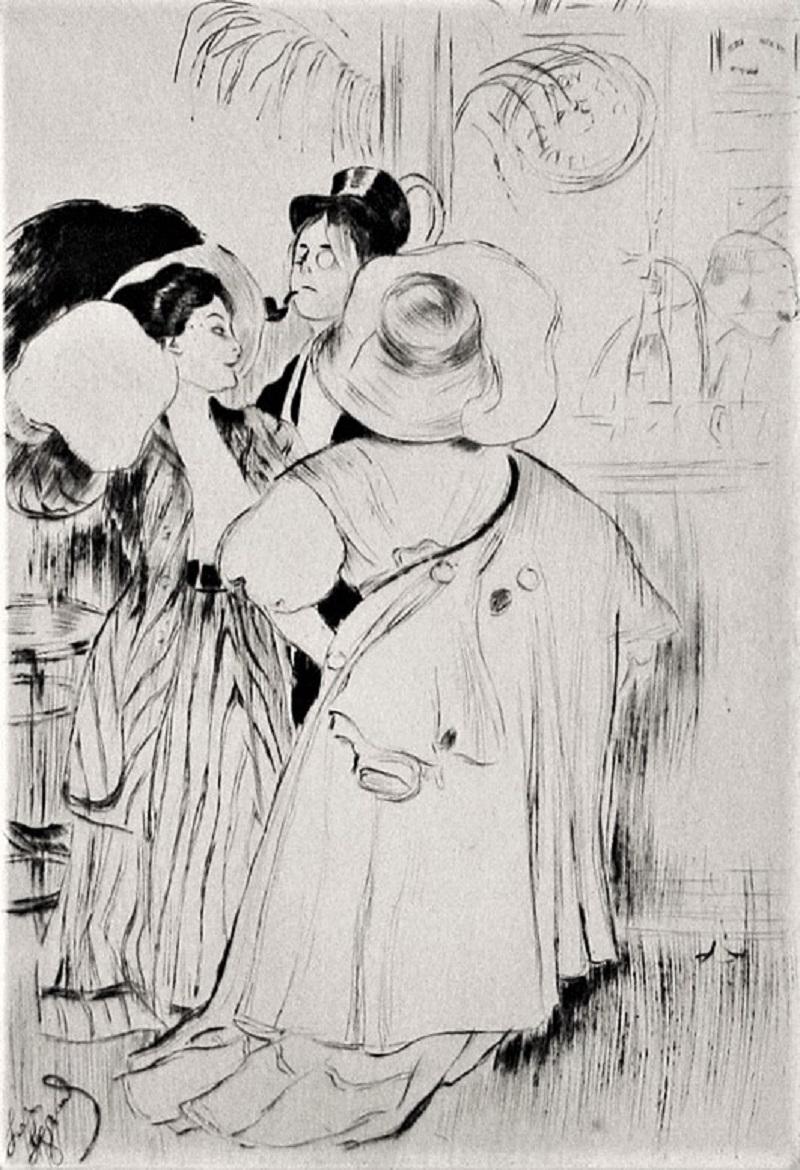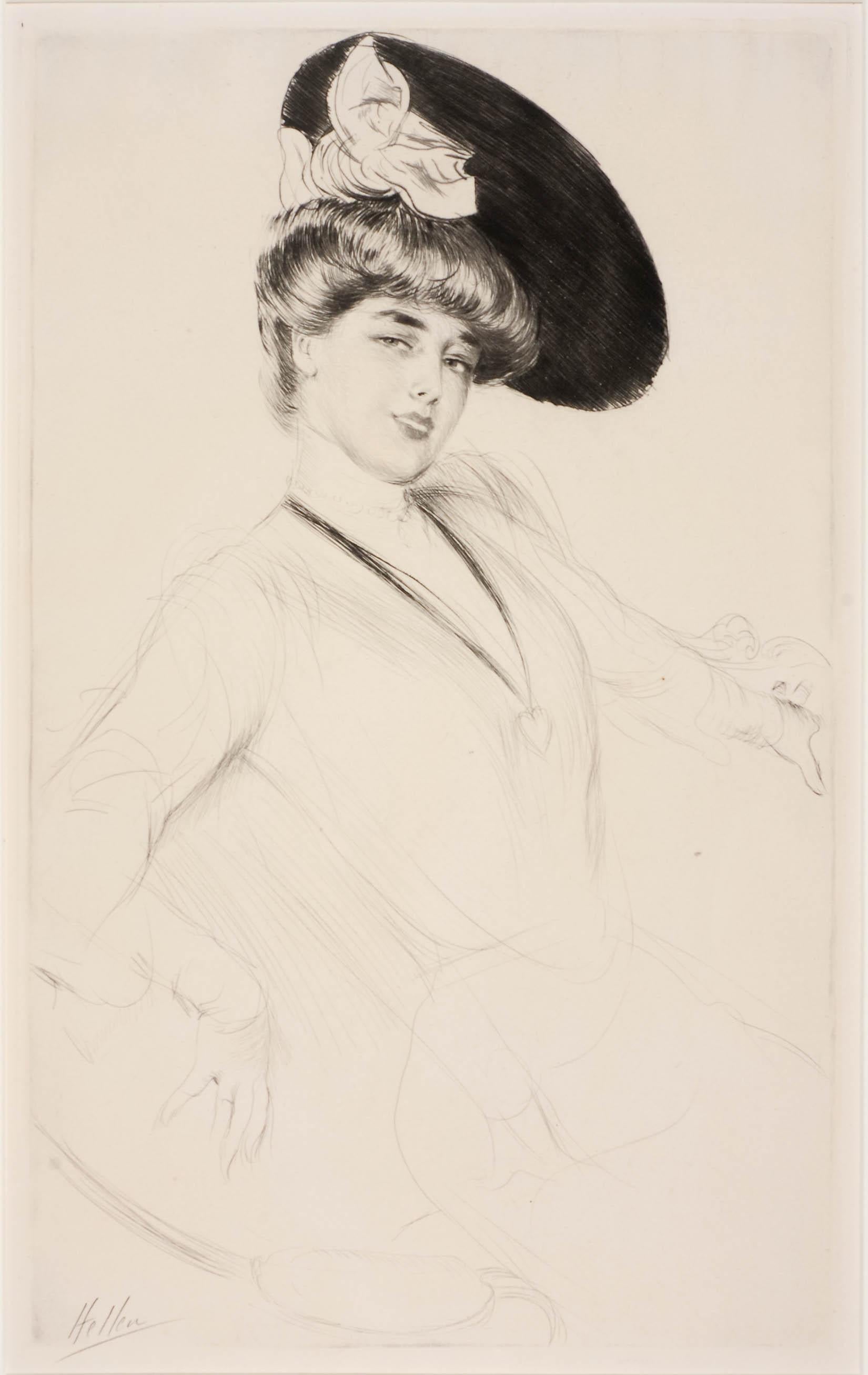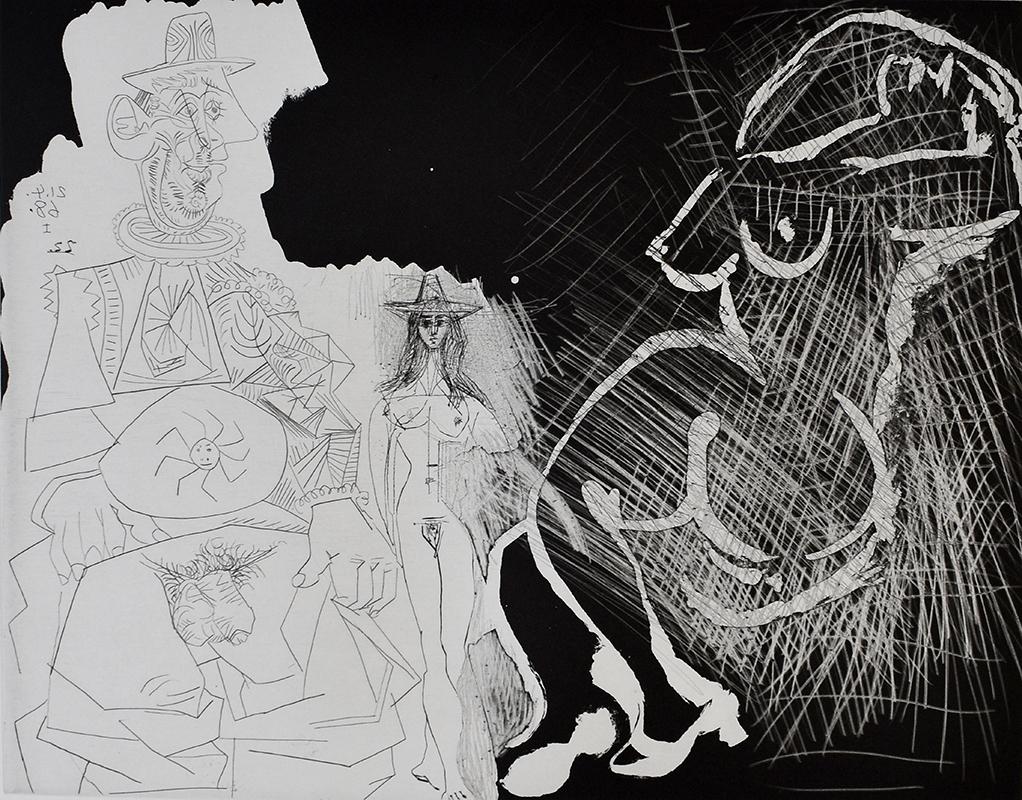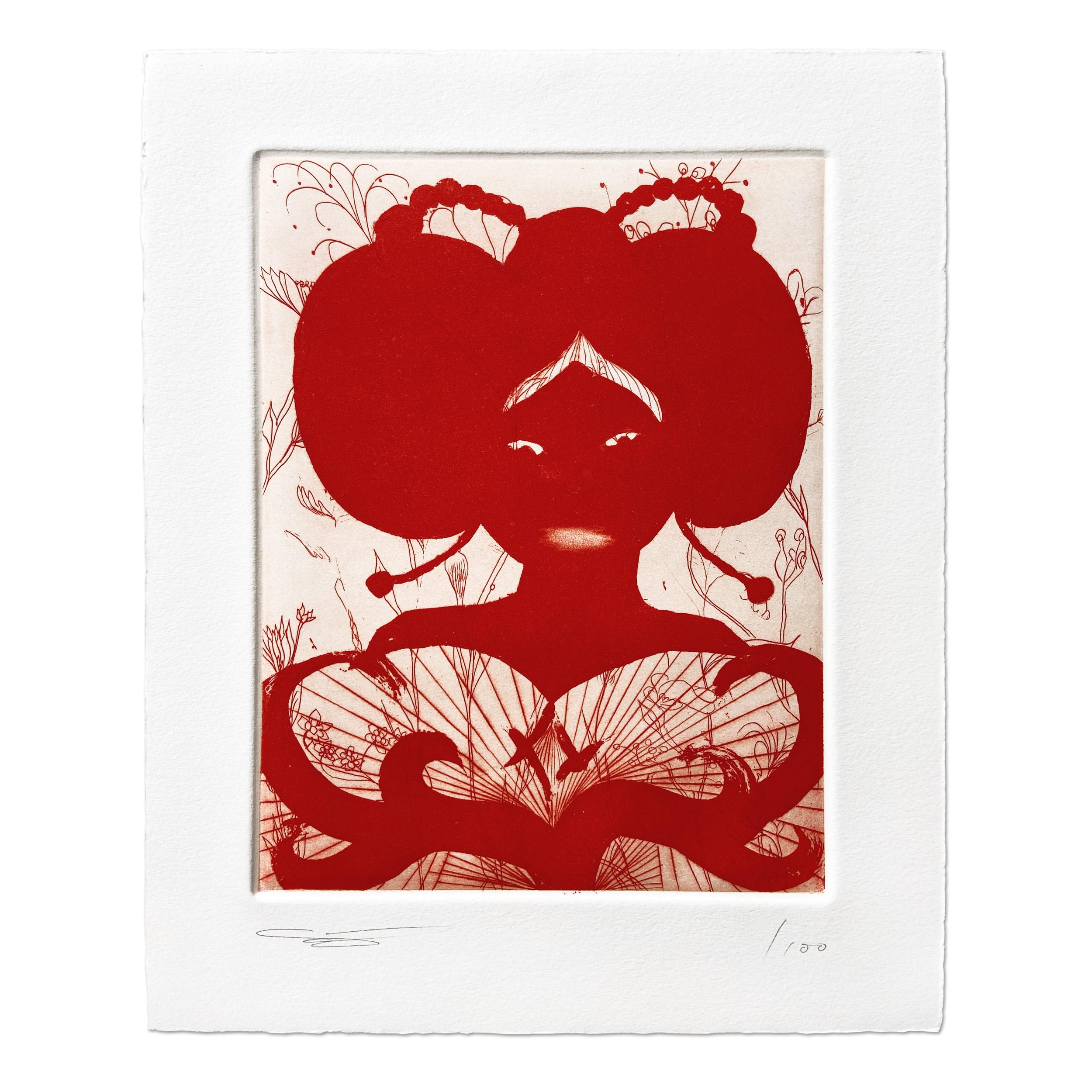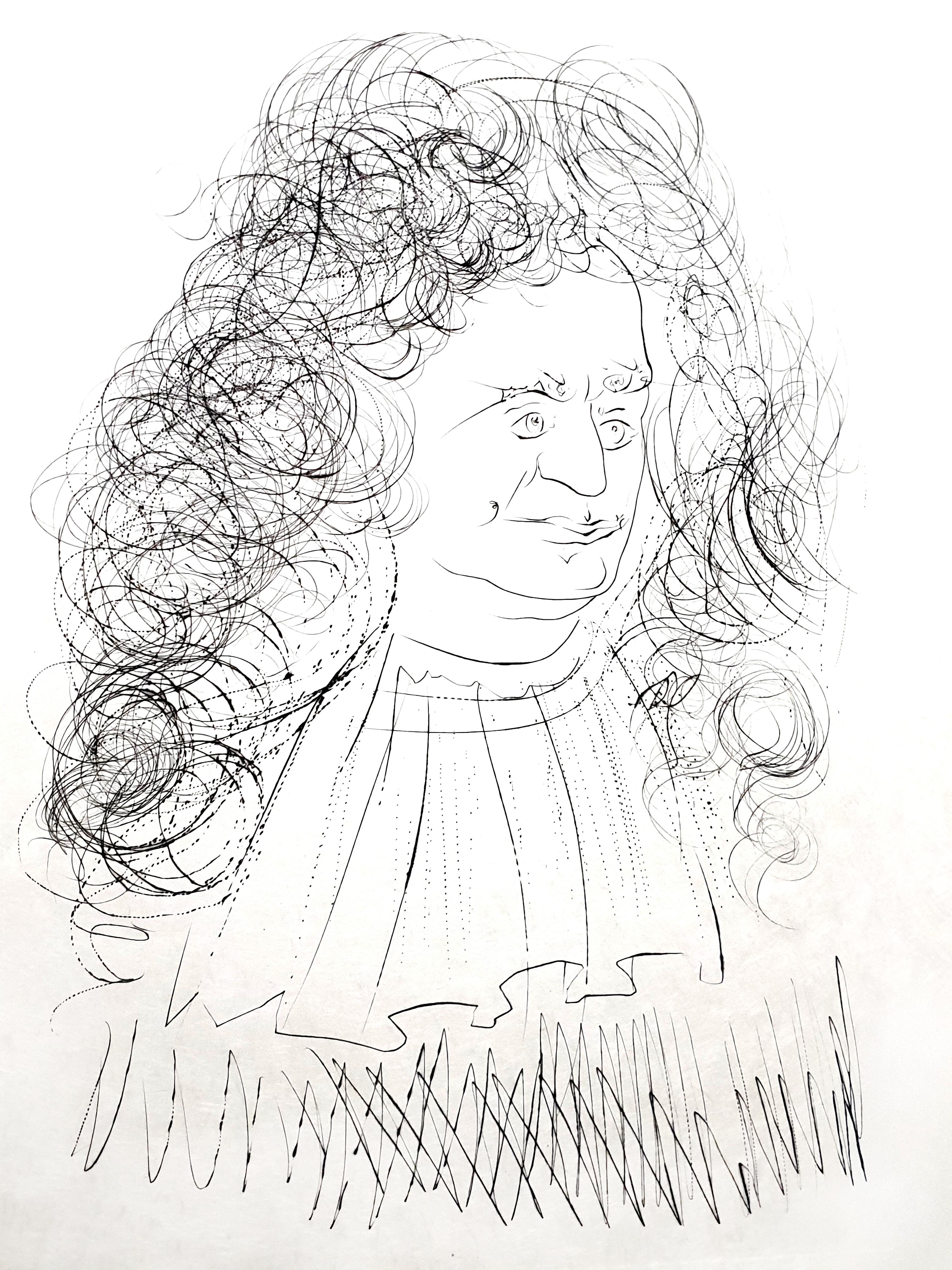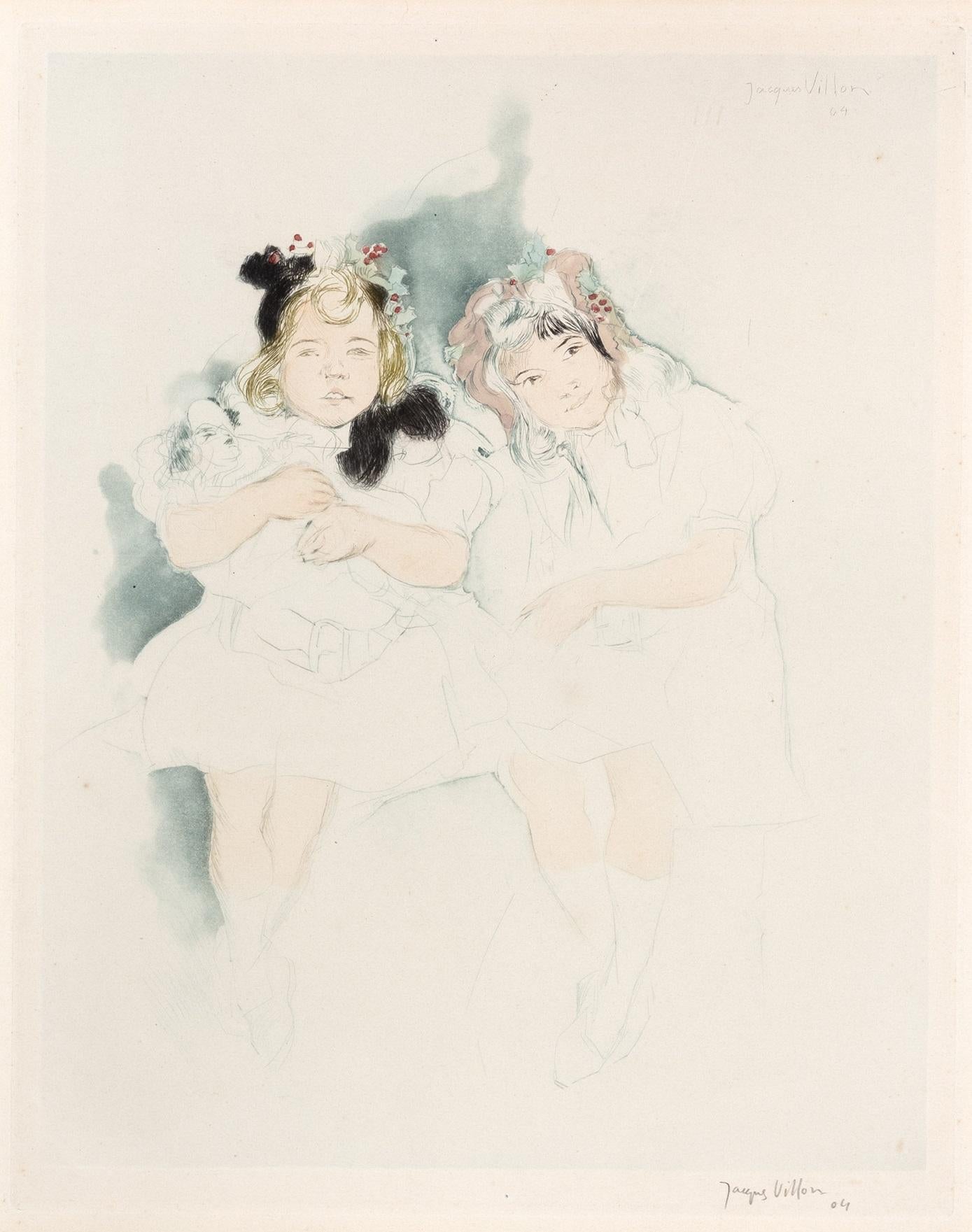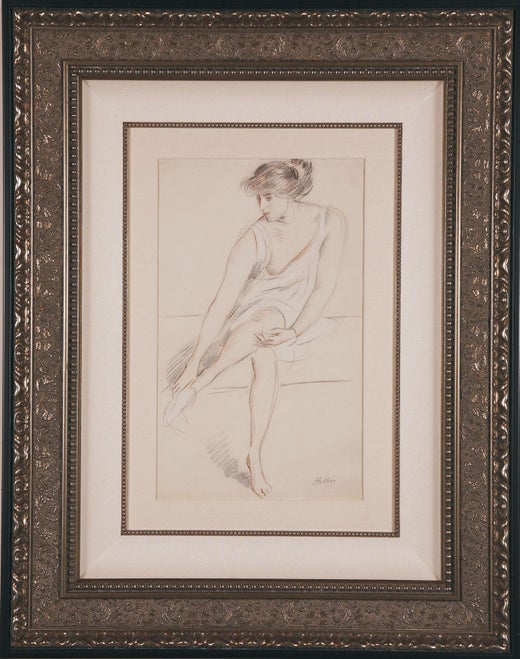Items Similar to "Madame Georges Menier" Portrait, by Paul Cesar Helleu
Want more images or videos?
Request additional images or videos from the seller
1 of 10
Paul César Helleu"Madame Georges Menier" Portrait, by Paul Cesar Helleu1900
1900
About the Item
HELLEU, PAUL CÉSAR
(1859 -1927)
"MADAME GEORGES MENIER"
Montesquiou XXI
Drypoint in colors, c. 1900
Signed in pencil, lower right
Printed on wove paper
Full Margins22 1/4”x 13 3/4”
Richly inked strong burr
No other artist epitomizes the whole atmosphere of elegance and hedonistic pleasure which pervaded Paris society at the first decade of the century as does Helleu. A close friend of Proust and the inspiration for one of the principal characters in La Recherche du Temps Perdu, Helleu’s whole lifestyle echoed the incomparable elegance and flow of his drawing, the sheer style of his art, and his eye for the poses of the beautiful women who were his friends and his patrons.During the 1870’s, Helleu had come to know the painters of Impressionism and also artists Sargent and Whistler who became his special friends and inspiration. By the early 1880’s, he had already developed the quality of expressive sweeping line, which is the essence of his drawing, but in 1885 he was encouraged by Tissot to try working on prints in drypoint. At this time, Tissot had decided, after the death of his lover and model Kathleen Newton, to travel to the Holy Land on an artistic pilgrimage. Having decided he would no longer engrave, he gave Helleu his diamond stylus...a literal and figurative “passing of the baton”. It was in the incision and texture of drypoint that his art was to reach one of its greatest peaks. He had an innate feel for the balance between a lightly curving stroke and the deeply cut highly tonal burr of the strongest drypoint. Around the turn of the century he started to combine drypoint with multi-inking in colors, the areas of color restricted to such touches as the bows on the hats, the hair color or the red of the lips. The plate was drawn at a single sitting, and then the color inks were brushed onto it. The results are some of the most splendid and decorative of all Belle Époque prints.
- Creator:Paul César Helleu (1859-1927, French)
- Creation Year:1900
- Dimensions:Height: 38.5 in (97.79 cm)Width: 28.5 in (72.39 cm)Depth: 2 in (5.08 cm)
- More Editions & Sizes:Limited edition hand signedPrice: $6,500
- Medium:
- Movement & Style:
- Period:
- Condition:
- Gallery Location:Hinsdale, IL
- Reference Number:
Paul César Helleu
Rich impression with dramatic drypoint burr and tone no other artist epitomizes the whole atmosphere of elegance and hedonistic pleasure which pervaded Paris society at the first decade of the century as does Helleu. A close friend of Proust and the inspiration for one of the principal characters in La Recherche du Temps Perdu, Helleu’s whole life style echoed the incomparable elegance and flow of his drawing, the sheer style of his art, and his eye for the poses of the beautiful women who were his friends and his patrons. During the 1870’s, Helleu had come to know the painters of Impressionism and also artists Sargent and Whistler who became his special friends and inspiration. By the early 1880’s, he had already developed the quality of expressive sweeping line, which is the essence of his drawing, but in 1885 he was encouraged by Tissot to try working on prints in drypoint. At this time, Tissot had decided, after the death of his lover and model Kathleen Newton, to travel to the Holy Land on an artistic pilgrimage. Having decided he would no longer engrave, he gave Helleu his diamond stylus…a literal and figurative “passing of the baton”. It was in the incision and texture of drypoint that his art was to reach one of its greatest peaks. He had an innate feel for the balance between a lightly curving stroke and the deeply cut highly tonal burr of the strongest drypoint. Around the turn of the century he started to combine drypoint with multi-inking in colors, the areas of color restricted to such touches as the bows on the hats, the hair color or the red of the lips. The plate was drawn at a single sitting, and then the color inks were brushed onto it. The results are some of the most splendid and decorative of all Belle Époque prints.
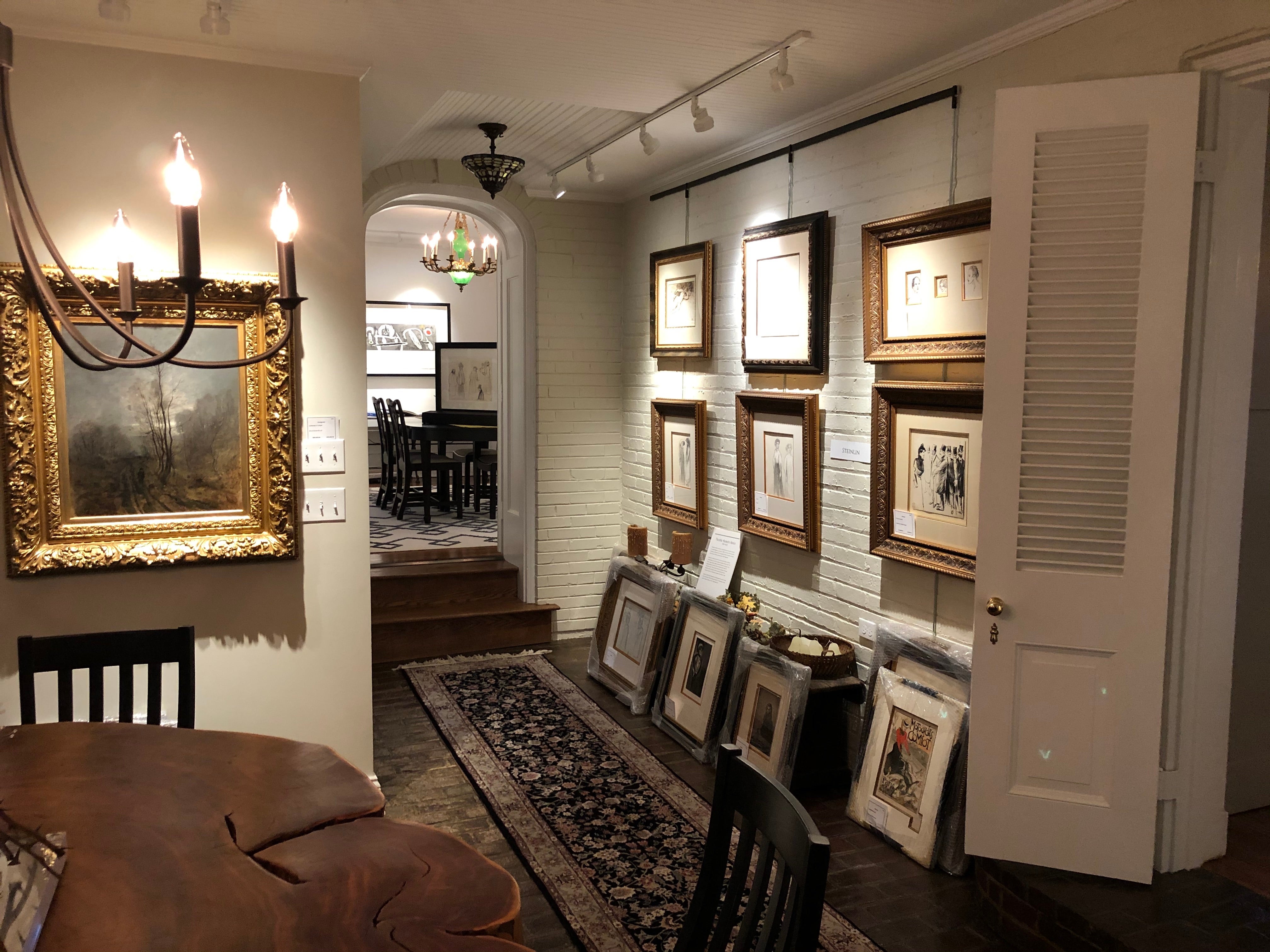
About the Seller
5.0
Vetted Seller
These experienced sellers undergo a comprehensive evaluation by our team of in-house experts.
Established in 1994
1stDibs seller since 2020
38 sales on 1stDibs
Typical response time: 3 hours
- ShippingRetrieving quote...Ships From: Hinsdale, IL
- Return PolicyA return for this item may be initiated within 14 days of delivery.
More From This SellerView All
- "Dame a la Toque", fabulous drypoint etching by Paul Cesar HelleuBy Paul César HelleuLocated in Hinsdale, ILHELLEU, PAUL CÉSAR (1859 - 1927) "La Dame a la Toque" (Lady in Fur Hat) Drypoint printed in colors on pale cream wove paper, c. 1906 Signed in black crayo...Category
Early 20th Century Post-Impressionist Portrait Prints
MaterialsDrypoint
- "Dame a la Toque", fabulous drypoint etching by Paul Cesar HelleuBy Paul César HelleuLocated in Hinsdale, ILHELLEU, PAUL CÉSAR (1859 - 1927) "La Dame a la Toque" (Lady in Fur Hat) Montesquiou XXXVI, c. 1906 Drypoint printed in colors on pale cream wove paper Sig...Category
Early 20th Century Post-Impressionist Portrait Prints
MaterialsDrypoint
- "Fillette Assise de Profil a Gauche" (Mlle. P), Paul Cesar HelleuBy Paul César HelleuLocated in Hinsdale, ILHELLEU, PAUL CÉSAR (1859 -1927) "Fillette Assise de Profil àGauche (Mlle. P) (Profile of a Seated Girl to the left) Drypoint in colors, c. 1895 Signed in pe...Category
1890s Abstract Impressionist Portrait Prints
MaterialsDrypoint
- "Dame a la Toque", fabulous drypoint etching by Paul Cesar HelleuBy Paul César HelleuLocated in Hinsdale, ILHELLEU, PAUL CÉSAR (1859 - 1927) "La Dame a la Toque" (Lady in Fur Hat) Montesquiou XXXVI, c. 1906 Drypoint printed in colors on pale cream wove paper Signed in black crayon lower ...Category
Early 20th Century Post-Impressionist Portrait Prints
MaterialsDrypoint
- "Une Mère et Enfant (Jean Renoir)"By Pierre-Auguste RenoirLocated in Hinsdale, ILRENOIR, PIERRE AUGUSTE (1841 -1919) "Une Mère et Enfant (Jean Renoir)" (Mother and Child) Delteil 10, Stella 10 Drypoint in color, 1896 Proof aside from the numbered edition of 100...Category
1880s Impressionist Portrait Prints
MaterialsEtching
- "Robe in Furnace" by Jim DineBy Jim DineLocated in Hinsdale, ILJim Dine Robe in Furnace Original etching in colors on copperplate deluxe paper From the rare, limited edition impression 4 of 31 Hand signed by artist and numbered Image Size 27...Category
1980s Abstract Expressionist Portrait Prints
MaterialsEtching
You May Also Like
- English BarBy Louis LegrandLocated in Storrs, CTEnglish Bar. 1908. Etching and drypoint. Exsteens catalog 275 state ii. 8 1/8 x 5 5/8 (sheet 17 3/8 x 12 1/4). Series: Les Bars. Edition 65 in this state (total edition 95). Printed ...Category
Early 1900s Art Nouveau Figurative Prints
MaterialsDrypoint, Etching
- Miss TaylorBy Paul César HelleuLocated in Fairlawn, OHMiss Taylor Drypoint, c. 1900 Signed in pencil lower left (see photo) Small edition, about 10 Very rich impression, full of burr Condition: Excellent Image size: 21-1/4 x 13-1/4" Sheet size: 25 3/8 x 18 5/8" Reference: Montesquiou XII Paul César Helleu was born in Vannes, Brittany, France. His father, who was a customs inspector, died when Helleu was in his teens. Despite opposition from his mother, he then went to Paris and studied at Lycée Chaptal. In 1876, at age 16, he was admitted to the École des Beaux-Arts, beginning academic training in art with Jean-Léon Gérôme. Helleu attended the Second Impressionist Exhibition in the same year, and made his first acquaintances with John Singer Sargent, James McNeill Whistler, and Claude Monet. He was struck by their modern, bold alla prima technique and outdoor scenes, so far removed from the studio. Following graduation, Helleu took a job with the firm Théodore Deck Ceramique Française hand-painting fine decorative plates. At this same time, he met Giovanni Boldini, a portrait painter with a facile, bravura style, who became a mentor and comrade, and strongly influenced his future artistic style. When he was 18 years old, Helleu established a close friendship with John Singer Sargent, four years his senior, that was to last his lifetime. Already becoming established, Sargent was receiving commissions for his work. Helleu had not sold anything, and was deeply discouraged almost to the point of abandoning his studies. When Sargent heard this, he went to Helleu and picked one of his paintings, praising his technique. Flattered that Sargent would praise his work, he offered to give it to him. Sargent replied, "I shall gladly accept this, Helleu, but not as a gift. I sell my own pictures, and I know what they cost me by the time they are out of my hand. I should never enjoy this pastel if I hadn't paid you a fair and honest price for it." With this he paid him a thousand-franc note. Helleu was commissioned in 1884 to paint a portrait of a young woman named Alice Guérin (1870–1933). They fell in love, and married on 28 July 1886. Throughout their lives together, she was his favourite model. Charming, refined and graceful, she helped introduce them to the aristocratic circles of Paris, where they became popular fixtures. On a trip to London with Jacques-Émile Blanche in 1885, Helleu met Whistler again and visited other prominent artists. His introduction to James Jacques Tissot, an accomplished society painter from France who made his career in England, proved a revelation. In Tissot, Helleu saw, for the first time, the possibilities of drypoint etching with a diamond point stylus directly on a copper plate. Helleu quickly became a virtuoso of the technique, drawing with the same dynamic and sophisticated freedom with his stylus as with his pastels. His prints were very well received, and they had the added advantage that a sitter could have several proofs printed to give to relations or friends. Over the course of his career, Helleu produced more than 2,000 drypoint prints. Soon, Helleu was displaying works to much acclaim at several galleries. Degas encouraged him to submit paintings to the Eighth Impressionist Exhibition in May and June 1886. The show was installed in a Paris apartment at 1 rue Laffitte, which ran concurrently with the official Salon that year to make a statement. Although 17 artists joined the famous exhibit that included the first Neo-Impressionistic works, Helleu, like Monet, refused to participate. Paul Helleu Sketching with His Wife (1889), by John Singer Sargent, The Brooklyn Museum, New York In 1886, Helleu befriended Robert de Montesquiou, the poet and aesthete, who bought six of his drypoints to add to his large print collection. Montesquiou later wrote a book about Helleu that was published in 1913 with reproductions of 100 of his prints and drawings. This volume remains the definitive biography of Helleu. Montesquiou introduced Helleu to Parisian literary salons, where he met Marcel Proust, who also became a friend. Proust created a literary picture of Helleu in his novel Remembrance of Things Past as the painter Elstir. (Later, Helleu engraved a well-known portrait of Proust on his deathbed.) Montesquiou's cousin, the Countess Greffulhe, enabled Helleu to expand his career as a portrait artist to elegant women in the highest ranks of Paris society, portraits that provide the basis for his modern reputation. His subjects included the Duchess of Marlborough, the Marchesa Casati...Category
Early 1900s Art Nouveau Portrait Prints
MaterialsDrypoint
- Caricature of General de Gaulle and Two Women, from: Series 347 - French SeriesBy Pablo PicassoLocated in London, GBPABLO PICASSO 1881-1973 Málaga 1881- 1973 Mougins (Spanish) Title: Caricature of General de Gaulle and Two Women, from: Series 347 Caricature du général de ...Category
1960s Portrait Prints
MaterialsDrypoint
- Chris Ofili, Untitled - 2000, Signed Aquatint and Drypoint Etching, British ArtBy Chris OfiliLocated in Hamburg, DEChris Ofili (British, b. 1968) Untitled, 2000 Medium: Etching, aquatint and drypoint, on Hahnemühle wove paper Dimensions: 25.7 × 20.8 cm (10 1/10 × 8 1/5 in) Edition of 100: Hand-si...Category
21st Century and Contemporary Contemporary Portrait Prints
MaterialsDrypoint, Etching, Aquatint
- Salvador Dali - La Fontaine Portrait - Handsigned EngravingBy Salvador DalíLocated in Collonge Bellerive, Geneve, CHSalvador Dali - La Fontaine Portrait - Handsigned Engraving 1974 Hand signed by Dali Edition: /250 The dimensions of the image are 22.8 x 15.7 inches on 31 x 23.2 inch paper Referenc...Category
1970s Surrealist Figurative Prints
MaterialsDrypoint, Aquatint
- "Mes Petites Amies, Les Deux Sœurs" signed by Jacques VillonBy Jacques VillonLocated in Milwaukee, WIThis is an original drypoint and aquatint artwork by Jacques Villon. The artist signed in pencil on the lower right. As well as signed in plate at the top right of the image. This is a wonderful artwork of different intaglio processes being brought together in a beautiful almost seamless harmony. The thin pencil like markings and hair detailing are made using the Drypoint printmaking method. Whilst the color details around the girls are made using the Aquatint etching method. Jacques Villon shows his skills as a printmaker with the way these pieces line up perfectly and with how clean the rest of the plate is around the girls. Catalogue Raisonne E101, pg. 66-67 (Ginestet & Pouillon. It depicts two young girls. 15" x 11 1/2" art 25 1/8" x 20" frame French painter, printmaker and illustrator. The oldest of three brothers who became major 20th-century artists, including Raymond Duchamp-Villon and Marcel Duchamp, he learnt engraving at the age of 16 from his maternal grandfather, Emile-Frédéric Nicolle (1830-94), a ship-broker who was also a much appreciated amateur artist. In January 1894, having completed his studies at the Lycée Corneille in Rouen, he was sent to study at the Faculty of Law of the University of Paris, but within a year he was devoting most of his time to art, already contributing lithographs to Parisian illustrated newspapers such as Assiette au beurre. At this time he chose his pseudonym: Jack (subsequently Jacques) in homage to Alphonse Daudet’s novel Jack (1876) and Villon in appreciation of the 15th-century French poet François Villon...Category
Early 1900s Modern Figurative Prints
MaterialsDrypoint, Aquatint, Etching, Intaglio
Recently Viewed
View AllMore Ways To Browse
George Diamond
Belle Epoque Portrait
Antique Hats Women
Antique Hair Bows
Splendid Antiques
Tonal Impressionism
Antique Hair Brush
Tissot Print
Whistler Drypoint
Womens Tissot
Tissot Antique
Belle Epoque Diamond Bow
Antique Hat Brush
Diamond Whistle
Tissot Diamond
White Minimalist Sculpture
Bronze Sculpture Of Children
Red Black Hat
